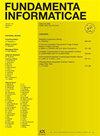Normal Form Nested Programs
IF 0.4
4区 计算机科学
Q4 COMPUTER SCIENCE, SOFTWARE ENGINEERING
引用次数: 17
Abstract
Disjunctive logic programming under the answer set semantics (DLP, ASP) has been acknowledged as a versatile formalism for knowledge representation and reasoning during the last decade. Lifschitz, Tang, and Turner have introduced an extended language of DLP, called Nested Logic Programming (NLP), in 1999 [1]. It often allows for more concise representations by permitting a richer syntax in rule heads and bodies. However, that language is propositional and thus does not allow for variables, one of the strengths of DLP. In this paper, we introduce a language similar to NLP, called Normal Form Nested (NPN) programs, which does allow for variables, and present the syntax and semantics. With the presence of variables, domain independence is no longer guaranteed. We study this issue in depth and define the class of safe NPNprograms, which are guaranteed to be domain independent. Moreover, we show that for NPNprograms which are also NLPs, our semantics coincides with the one of [1]; while keeping the standard meaning of answer sets on DLP programs with variables. Finally, we provide an algorithm which translates NPNprograms into DLPprograms, and does so in an efficient way, allowing for the effective implementation of the NPNlanguage on top of existing DLP systems.格式嵌套程序
在答案集语义(DLP, ASP)下的析取逻辑规划在过去十年中已被公认为知识表示和推理的通用形式。Lifschitz、Tang和Turner在1999年引入了一种扩展的DLP语言,称为嵌套逻辑编程(NLP)。它通常允许在规则头部和主体中使用更丰富的语法,从而实现更简洁的表示。然而,该语言是命题式的,因此不允许变量,这是DLP的优势之一。在本文中,我们介绍了一种类似于NLP的语言,称为范式嵌套(NPN)程序,它允许变量,并呈现语法和语义。有了变量,就不再保证域的独立性。我们对这一问题进行了深入的研究,并定义了一类安全的npn规划,该类规划保证是域独立的。此外,我们证明了对于同样是nlp的npnprogram,我们的语义与[1]的语义一致;同时在具有变量的DLP程序中保持答案集的标准含义。最后,我们提供了一种将npn程序转换为DLP程序的算法,并且以一种有效的方式进行,从而允许在现有DLP系统之上有效地实现npn语言。
本文章由计算机程序翻译,如有差异,请以英文原文为准。
求助全文
约1分钟内获得全文
求助全文
来源期刊

Fundamenta Informaticae
工程技术-计算机:软件工程
CiteScore
2.00
自引率
0.00%
发文量
61
审稿时长
9.8 months
期刊介绍:
Fundamenta Informaticae is an international journal publishing original research results in all areas of theoretical computer science. Papers are encouraged contributing:
solutions by mathematical methods of problems emerging in computer science
solutions of mathematical problems inspired by computer science.
Topics of interest include (but are not restricted to):
theory of computing,
complexity theory,
algorithms and data structures,
computational aspects of combinatorics and graph theory,
programming language theory,
theoretical aspects of programming languages,
computer-aided verification,
computer science logic,
database theory,
logic programming,
automated deduction,
formal languages and automata theory,
concurrency and distributed computing,
cryptography and security,
theoretical issues in artificial intelligence,
machine learning,
pattern recognition,
algorithmic game theory,
bioinformatics and computational biology,
quantum computing,
probabilistic methods,
algebraic and categorical methods.
 求助内容:
求助内容: 应助结果提醒方式:
应助结果提醒方式:


